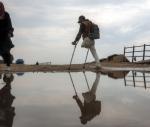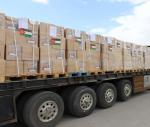You are here
Soil pollution in a warming world
Feb 04,2024 - Last updated at Feb 04,2024
Soil is a vital natural resource that sustains life on our planet. It serves as the foundation for habitats, agriculture, food, resources, nutrients and biomass. Additionally, soil plays a crucial role in regulating water quality, supporting biodiversity, and sequestering carbon. However, in recent decades, soil pollution has emerged as a global environmental challenge that threatens our well-being and the health of ecosystems. This article delves into the complex issue of soil pollution, exploring its causes, consequences and potential solutions.
When talking about the causes of soil pollution, almost all experts agree that industries generate the widest arrays of hazardous chemicals and waste products, many of which find their way into the soil. Contaminants such as heavy metals, solvents and petroleum products can leach into the ground, contaminating the soil. Add to this modern agriculture which relies heavily on pesticides, herbicides, hormones and synthetic fertilisers. The excessive use and improper disposal of these chemicals and compounds can lead to soil contamination.
Improper disposal of solid waste, including municipal, industrial, radioactive, clinical and electronic waste can result in soil pollution. Landfills and dump sites, if not managed properly, can release toxins into the surrounding soil and underground water, especially radioactive waste that can last for millions of years. Runoff from agricultural lands can also carry these pollutants into nearby soil and water bodies.
Soil pollution can also harm soil-dwelling organisms, oxygen level, disrupt soil food chains, and reduce biodiversity. This, in turn, affects the health of ecosystems and their ability to provide their designed essential services. Soil pollution affects the food chain, posing health risks to humans and wildlife. Exposure to heavy metals like lead, mercury and cadmium can lead to various health problems, including developmental issues in children.
Mining operations involve the extraction of minerals, metals and ores from the soil, which can expose soluble and radioactive materials that release harmful substances into the soil and underground water. Acids and other toxins which are used in mining can add to the calamity. In Jordan, areas of phosphate mining, for example, are highly susceptible to such pollution, both chemical and radioactive.
Urban expansion, infrastructure and construction activities can disrupt soil ecosystems and introduce pollutants and construction debris, into the ground. The removal of forests due to urban expansion can lead to soil erosion and degradation, causing loss of topsoil and thus exposing the soil and groundwater to pollutants.
Consequences of soil pollution are many, such as reduced agricultural productivity, as contaminants can affect soil fertility, therefore impacting food production. Pollutants in the soil can leach into groundwater, contaminating drinking and irrigation water sources. This eventually poses a severe health risk to communities that rely on groundwater for drinking and agriculture.
Solutions to soil pollution include preventive measures. The most effective way to address soil pollution is through prevention. Implementing stricter regulations on industrial waste disposal, nuclear power plants, mining, chemical use in agriculture and waste management practices can help reduce the introduction of pollutants and radioactivity into the soil.
Adopting sustainable agricultural practices, such as organic farming, crop rotation and integrated pest management, can minimise the use of harmful chemicals and promote soil health. Key features of Integrated Pest Management include regular monitoring and assessment of pests to evaluate their prevalence and impact on crops, and taking necessary measures only when pest populations exceed this threshold.
Measures include the use of biological and mechanical techniques, such as incorporating the use of beneficial organisms and mechanical control techniques as alternatives to chemical pesticides. Also, using diverse groups of crops to reduce the likelihood of pest spreading. Remediation techniques can also be used, for example soil remediation technologies, such as phytoremediation (using plants to remove contaminants), bioremediation (using microorganisms to degrade pollutants), and soil washing can be employed to clean up contaminated sites. Proper urban planning and zoning regulations can help prevent soil pollution in urban areas. Contaminated industrial sites can be repurposed for non-residential purposes to limit human exposure.
Governments and regulatory bodies should establish and enforce strict environmental regulations to monitor and control soil pollution. Penalties for non-compliance should act as a deterrent. Improved waste management practices, including recycling and safe disposal of hazardous waste, can prevent soil contamination from landfills and dumpsites.
In conclusion, soil pollution is a pressing environmental issue with far-reaching consequences for ecosystems, agriculture and human health. Addressing this challenge requires a holistic approach that encompasses preventive measures, sustainable practices, remediation techniques and robust regulatory frameworks. By taking proactive steps to mitigate soil pollution, we can protect this vital resource and ensure a healthier and more sustainable future for existing generations and those to come.
Ayoub Abu Dayyeh is an energy and green buildings consultant














Add new comment